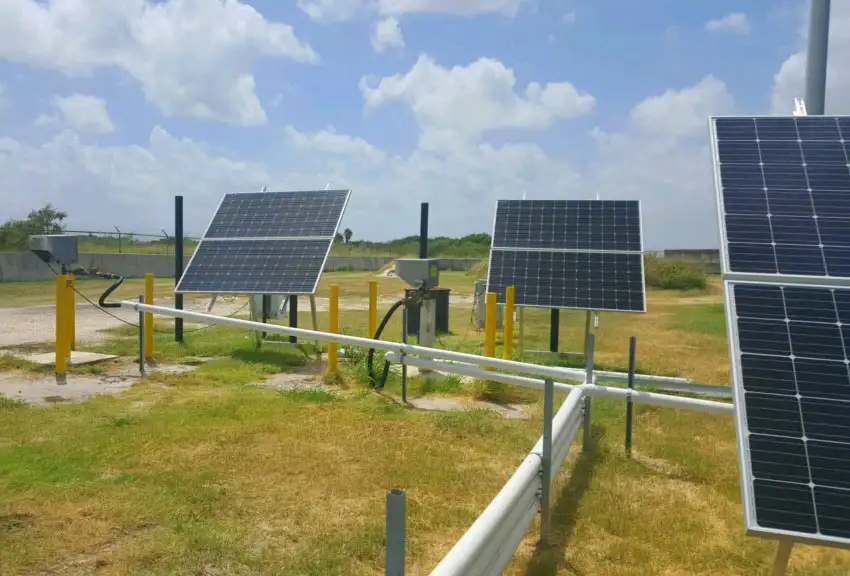By themselves, each of the three components has a long history:
- The downhole piston technology has been the heart of windmill-driven water wells and electrically powered oilfield pump jacks for more than a century. The top-head-drive motors are mounted above the wellhead and link with a positive-displacement piston that draws liquid to the surface in controlled, even strokes. Piston pumps today have been re-imagined, re-sized, improved and often tailored to the needs of individual sites.
- The top-head linear-rod is one of the simplest and most reliable drive-motor transmission technologies. The power source turns a crank that converts rotary motion to reciprocating linear motion, which alternately lifts and lowers a flexible rod connected the downhole piston. Drivers are lightweight (50 pounds), low-profile (4 feet) and easily moved from well to well.
- The solar panel collects energy from the sun, which powers the DC driver motor.

Blackhawk Apollo Solar pump operating at Midwest landfill during winter.

Shoreline remediation/recovery pumping.

Horizontal leachate pumping at California landfill.
Add connections, a solar converter, a lubricator, a backup battery if desired – that’s about it.
Advantages
Advantages are many: Positive-displacement solar piston units pump virtually anything that flows, including high temperature, viscous or foamy fluids at any pH; operate at any angle including horizontal; are unaffected by changes in positive or negative pressure; can run dry without harm; pump to the bottom of the well or sump independent of static head, and do not shear fluids – all at a controlled, constant-flow rate independent of liquid head.
Because all power and drive mechanics are outside the well, servicing is faster and less frequently needed, safer for workers, with no pump pulling.
Solars are non-polluting -- there is no contaminated compressed air exhausted into the atmosphere. And materials of construction are easily interchanged to allow solar pumps to operate in extremely difficult applications, including elevated-temperature wells beyond 200°F / 93°C.
Depending upon model, solar units can pump to 400 feet/ 122 meters TDH or with flows to 2.7 gallons / 10.2 liters per minute.
What About Clouds and Latitude?
Yes, the sun doesn’t always shine. Fortunately, today’s solar systems operate on cloudy days and in winter, but, as to be expected, full clouds reduce effectiveness to roughly 25 per cent as full sunshine.
A metered test of solar-drive piston pumps during winter demonstrated impressive results at an upper Midwest landfill gas system at 42°+ latitude, roughly as northerly as Toronto.
Most days were cloudy – 65% to 76% through March, with 10-11 hours of daylight. The pumps operated during the day and were shut off after sundown. Although 12-volt storage battery systems were available, test pumps operated independently of backup.
Low-flow solar pumping proved effective in lowering liquid levels to intake and maintaining the reduced levels throughout the day; on-off matched the day-night cycle. Three to four feet of liquid accumulated in the wells during the nighttime hours, but morning pumping reduced levels to intake. Results were consistent day to day. More screen was exposed, and the overall efficiency of the gas system improved by 20%.
History of Versatility
Solar top-drive piston pumps first made their appearance on landfills in 2012, mostly as gas-well dewatering pumps at closed sites. As word spread of their reliability and simple, low-maintenance operations, solars became popular in locations from East Coast Superfund sites to remote Western mega-landfills.
Refineries began installing solars to slowly “sip” underground hydrocarbon plumes to recover leaked oil without disturbing the pools and roiling groundwater. Old, retired electric-power utility plants began managing coal-ash ponds with solar pumping.

Solar pump removing sump condensate at Midwest biogas operation.
Most recently, piston solars have been employed to pump condensate sumps at a massive farm methane biogas operation and condensate pots at a big-city gas-tunnel system.
Of course, solar-drive piston pumps are still making inroads in landfills. A solar pump with performance comparable to a traditional air-drive submersible requires only one-fifth of the electric power needed for pneumatic systems – solar systems convert sunshine to direct current. Prices for panels have decreased more than 60% over the past decade, driven by technological improvements, the EnergySage solar marketplace reports.
Lessons Learned
There have been bumps along the way in introducing solar pumping in applications dominated by traditional pumps. Early models required regular replacement of electric motor brushes – brushless models now are standard. Winter operations required blanketing and taping of piping to avoid freezing. A perceived hurdle, training site technicians to install and service the pumps, has been overcome more easily than expected at solar sites.
The payoff for managers and engineers has been significant. “The sun is a free power source,” said a U.S. landfill engineer well-experienced with solars. “I like the fact that nearly all the mechanical parts are above grade and not in leachate. I also like that the parts are pretty interchangeable from pump to pump. A manufacturer can improve on the design, but you are able to build up old solar pumps with new technology. Something small, but I don’t have to replace a whole system when I need a repair. And I like the idea of pushing back against pneumatic power,” the engineer said. “My biggest factor on solar is the ability to move it from well to well and not have to run new lines. It’s a contained system that powers itself.”
Mark Bertane is the principal executive of Blackhawk Technology Company. pump.info@blackhawkco.com




